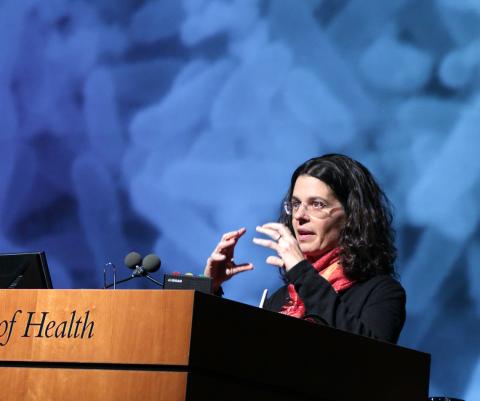Understanding the Metabolism of Bacteria Could Lead to Therapies

Photo: Bill Branson
Colonies of bacteria that attach to moist surfaces called biofilms can be found in many places—from the rust-colored sediment at the bottom of a lake to the lungs of a cystic fibrosis patient.
Learning how these bacterial colonies obtain the energy and nutrients they need to survive may one day lead to more effective treatments for bacterial infections, said Dr. Dianne Newman at a Wednesday Afternoon Lecture in Masur Auditorium on Jan. 13.
“Microbes have been dominating the biosphere for a large part of Earth’s history,” said Newman, professor of geobiology at California Institute of Technology’s division of geological and planetary sciences and division of biology. “For much of microbial history, the Earth did not have oxygen.”
Today, however, researchers often study microbes like bacteria only in oxygen-rich environments—overlooking their ability to switch easily to a no-oxygen setting. In her lab, Newman studies Pseudomonas aeruginosa PA14, a common bacterium that infects the lungs of patients with cystic fibrosis. She noted it takes about half an hour for P. aeruginosa to double in size in an oxygen-rich lab. If its growth were unchecked for a week, there would be enough bacteria to fill the volume of the known universe.
“Sustained fast growth rates are really lab artifacts and in the environment, obviously, this is not what’s going on,” Newman said.
Instead, something entirely different happens. Once biofilms reach a certain size, “the rate of oxygen consumption outpaces the rate of diffusion. Large portions of the biofilms are hypoxic or anoxic.” In other words, under low oxygen conditions, bacteria transition from an exponential growth phase to a stationary phase.
Take, for example, Shewanella oneidensis MR1, a bacterium first discovered at the bottom of Oneida Lake in New York. The organism forms biofilms on the surface of iron oxide minerals, which it utilizes to gain energy. When the biofilm grows large enough, the bacteria in the middle don’t have access to oxygen or to the mineral. The middle bacteria, however, stay metabolically active. Early in her research, she suggested these bacteria produce extracellular organic molecules that allow electrons to move from the bacteria to the mineral.
A chemical process like this also happens in the lungs of patients with cystic fibrosis. Those with CF produce too much mucus in their lungs. The mucus blocks airways and makes it easy for bacteria to grow. Newman’s lab has a space in the CF pediatric clinic at Children’s Hospital Los Angeles in which they can analyze mucus as soon as it’s coughed up.
“Within these lungs, over time, a complex microbial community can accumulate and the composition of this community can be very different from patient to patient. Yet, it’s fair to say that, among the pathogens that grow to be very successful in this habitat, is P. aeruginosa,” she said.
When P. aeruginosa cultures grow large enough, Newman explained, the bacteria produce phenazines—a type of molecule that is harmful to white blood cells called neutrophils and can limit the growth of other bacterial strains in the presence of oxygen.
In the absence of oxygen, phenazines accept excess electrons within cells that can’t access oxygen or a mineral. This allows cells in the middle of the biofilm to remain viable. The phenazines transfer their electrons to something outside of the cell, such as oxygen or iron, allowing them to be recycled by the bacteria.
“As lung function declines, the concentration of phenazines rises very significantly,” she said. Before the decline, Newman has observed a higher concentration of a type of phenazine called pyocyanin.
Building upon her work with phenazines, Newman hopes to learn more about other aspects underpinning how P. aeruginosa survives under the slow-growth, anoxic conditions inside the lung mucus.
Insights into these processes may one day provide new avenues for treating the bacteria that colonize the lungs of people with cystic fibrosis, such as disrupting phenazine cycling in this environment.
